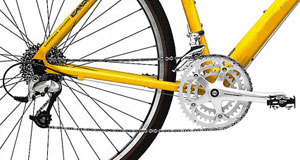How Do I Shift Gears On My Bike?
Shifting GearsThe ins and outs of using your bike gears effectively |
|
When you hear that a bicycle has "twenty one" or "twenty four" gears, it sounds complicated. It really just means that there are plenty of gears and that you'll have an easy time pedaling your bike regardless of what the road or trail throws at you. Still, having all those gears can be a bit daunting. Do you wonder which to use and how often to shift? Well, to put your mind at rest and have you shifting like a pro in no time, we've prepared this easy guide.
So read along or watch the video we've added below.

By: Matt Donovan,
3rd generation Owner and General Manager of Dedham Bike
Last updated: 8/10/23
You're The Engine
One of the main sources of confusion is thinking of bicycle shifting in car terms. Bikes aren't shifted like cars. You don't start in first gear, shift into second, and so on. Instead, you shift by how your legs and lungs feel.As the engine for the bike, you're most efficient pedaling at a steady and maintainable pace (called "cadence," or the number of times one foot goes around in a minute). For most people a cadence of about sixty to seventy rpm (revolutions per minute) feels comfortable.
Once you're pedaling comfortably, you shift gears every time you feel your legs starting to strain or spin too quickly. For the former, you shift to an easier gear. For the latter, you shift into a harder one.
In other words, there's no right or wrong gear to be in. Just use the one that feels right for your legs and breathing at the time. This means that, unless you live where all the rides are pancake flat, you're shifting a lot to keep your pedaling cadence and riding effort steady, which ensure that you complete your rides comfortably.
Changing Gears
You probably already know that you must be pedaling in order to shift. And it's also important to ease the pressure off the pedals during the gear change. This makes the shift smoother and prevents possible drivetrain glitches. In order to do this on a hill, anticipate the steep section and shift into an easier gear before you get there. Keeping constant hard pressure on the pedals will make it harder for the gears to shift properly.
Shifting is done by moving the shift levers. You shift when your legs are working too hard or spinning too fast because conditions have changed. To make a good shift, all you need to know is whether you want to make it easier or harder to pedal and by how much.
How do you know which lever to shift (never shift them simultaneously)? The right lever makes small differences in pedaling effort and is usually clicked once or several times. Shifting this lever moves the chain across the cluster of cogs on the rear wheel. On a newer bike, there are eight or nine cogs and they only vary slightly in size. The larger the cog, the easier it is to pedal and vice versa.
Contrarily, the left lever makes larger differences in effort. Use it to make it considerably harder or easier to pedal. Operating this lever moves the chain between the two or three chainrings on the front of your drivetrain. Here, the larger the ring, the harder it is to pedal and vice versa.
One way to remember where you are in the gears: When the chain is closer to the bike, front or rear, you're in your easier gears. As the chain shifts away from the bike (to the right), the gears get harder.
A Shifting Example
So, a short ride might go something like this: You roll out of your garage and start pedaling and find the going too difficult. You click the right lever once but it's still way too hard. So, you shift the left lever, which makes it much easier and lets you spin your legs at a good pace. You cruise toward the lake feeling fine but then your legs get heavy. A headwind! You shift the right lever twice and find a good rhythm again.
Toward the backside of the lake, there's a short steep climb. You shift the right lever each time the hill steepens until you're in your easiest gear. Cresting the hill, it's all downhill home with a tailwind. Yes! You pick up speed quickly. You keep pedaling to match the wind's speed and get the workout. You shift the right lever but need a larger change so you shift the left and head for home lickety-split.
You'll get better at shifting with practice so don't be afraid to shift a lot. You can't hurt the gears and it's the best way to familiarize yourself with them. After a few rides, shifting will become natural and you won't even think about it and all those gears (except for being glad every time the road heads uphill).
Some FAQ's
1) How do I shift gears on a mountain bike?
Your bike will come with either one or two shifters with a couple of paddles which will allow you to increase or decrease the tension on the pedals. What each of these paddles control will depend on the brand of shifter you have. The key is to experiment with your shifters before heading out on the road or trail. And remember, you always want to be pedaling forward when shifting for your gears to work smoothly.
2) How do I shift gears on a road bike?
Most road bikes use a break lever / shifter combo to shift your bike. What this means is that the brake lever and shifter are one unit. If you have Shimano shifters you will swing the brake lever in towards the front wheel to get your derailleur to shift up or down. On the right shifter that controls the rear gears, by swinging the brake lever inwards you will decrease tension on the pedals. On the left shifter, you will be controlling the front derailleur. By swinging the brake lever inward you will increase the resistance at the pedals. Now, you will notice on Shimano shifters you have your brake lever as well as a smaller paddle that nests in behind the brake lever, this paddle will have the opposite action of your brake lever in either case. So on the right side the paddle clicks will increase resistance / tension while on the left shifter it will decrease it.
If you have SRAM shifters it is a bit different in that you will only shift using the paddle behind the brake lever. All your shifting is done using that paddle. One click of the paddle on the right / rear shifter will decrease your resistance while double clicks will increase it. The opposite occurs on the left / front shifter, one big swinging click increases your resistance while one quick click will decrease the tension at the pedals.
Watch This Gear Shifting Video
Video Is Courtesy Of The Global Cycling Network

